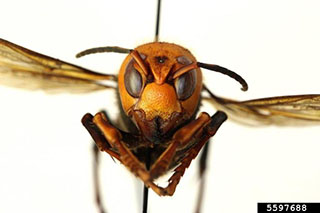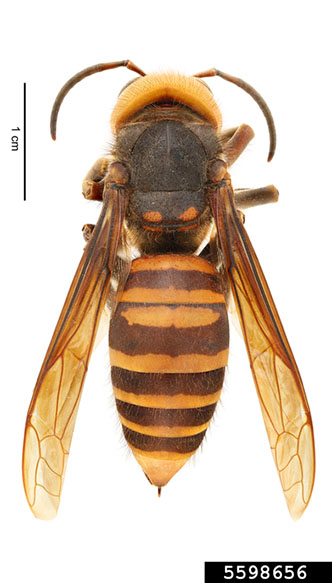Asian Giant Hornet
What is the Asian Giant Hornet?

Photo Credit: Washington State Department of Agriculture, Bugwood.org
The Asian Giant Hornet (AGH) is the world’s largest hornet, measuring 1.5 to 2 inches in length. The hornets have a yellow to orange head, a black thorax and black and orange/yellow striped abdomen. AGH is native to Japan, Korea and other parts of Asia. This pest was first detected in the United States in the state of Washington in December 2019.
What is the risk?
This invasive pest can attack honey bees. It only takes a few AGH to attack a honey bee hive and kill the entire hive in a matter of hours. AGH is often referred to as the ‘murder hornet’ due to their venomous stings. Although in rare circumstances they can be dangerous to humans, the real threat of AGH is to honey bees.
What is Missouri doing to guard against AGH?
Although AGH would have some hurdles to cross to successfully establish here in Missouri, we are still keeping an eye out for this invasive pest. The climate in Missouri would make it difficult for AGH to establish. It would also be hard for them to reach Missouri due to the natural land barrier of the Rocky Mountains. At this time, the AGH has only been found in the state of Washington. The Washington Department of Agriculture has been successful in eradicating AGH nests that have been found.
Look-Alikes
There are several look-alike species of similar size found here in Missouri. Figures 1 and 2 show two common look-alike species found in Missouri. Check out this guide to learn more about the different look-alikes.
Eastern Cicada Killer

Asian Giant Hornet

Photo Credit: Hanna Royals, Museum Collections: Hymenoptera, USDA-APHIS PPQ, Bugwood.org
Figure 1: Cicada Killers are common in Missouri and are of no concern. They are similar in size to AGH, but have black and yellow markings on the abdomen.
European Hornet

Asian Giant Hornet

Photo Credit: Hanna Royals, Museum Collections: Hymenoptera, USDA-APHIS PPQ, Bugwood.org
Figure 2: The European Hornet is much smaller in size compared to AGH. It also has tear drop shaped markings on the abdomen. The European hornet is common in Missouri and not a concern.
Lifecycle Description
Spring: A mated queen emerges after the winter and looks for a suitable nesting site. Often times, queens look for a preexisting underground cavity to build a nest.
Summer: Once the queen finds a suitable nest location, she builds a nest, gathers food, lays eggs and cares for the young. When there are enough workers to sustain the nest, the queen becomes nest-bound and the workers perform all the duties outside the nest.
Late Summer/Early Fall: During this time frame, the colony begins to produce males and next year’s queens. To obtain food for the new young, workers leave the nest in search for higher protein food. These workers may attack honey bee hives and other social bees and wasps.
Fall: Males leave the nest and perch at the entrance of it to mate with a new queen. The queens must mate before overwintering because males will not be present in the spring when the queens emerge.
Winter: After the new queens mate, they will overwinter in a sheltered spot until spring. Once spring rolls around, the queens emerge and the cycle starts all over again.
How can you help?
Report any Asian Giant Hornet sightings. The Asian Giant Hornet’s venomous sting makes these insects potentially dangerous, so be cautious if you believe you have seen one. Please include the following information:
- Your name and contact information
- Location of sighting
- Photograph of the hornet (we cannot confirm a report without a photo)
- If the suspected sighting is NOT in Missouri, please submit the report to your state’s department of agriculture.
Early detection is key! Collect a specimen if possible or take a photo. Report suspect insects to plantpest@mda.mo.gov.
